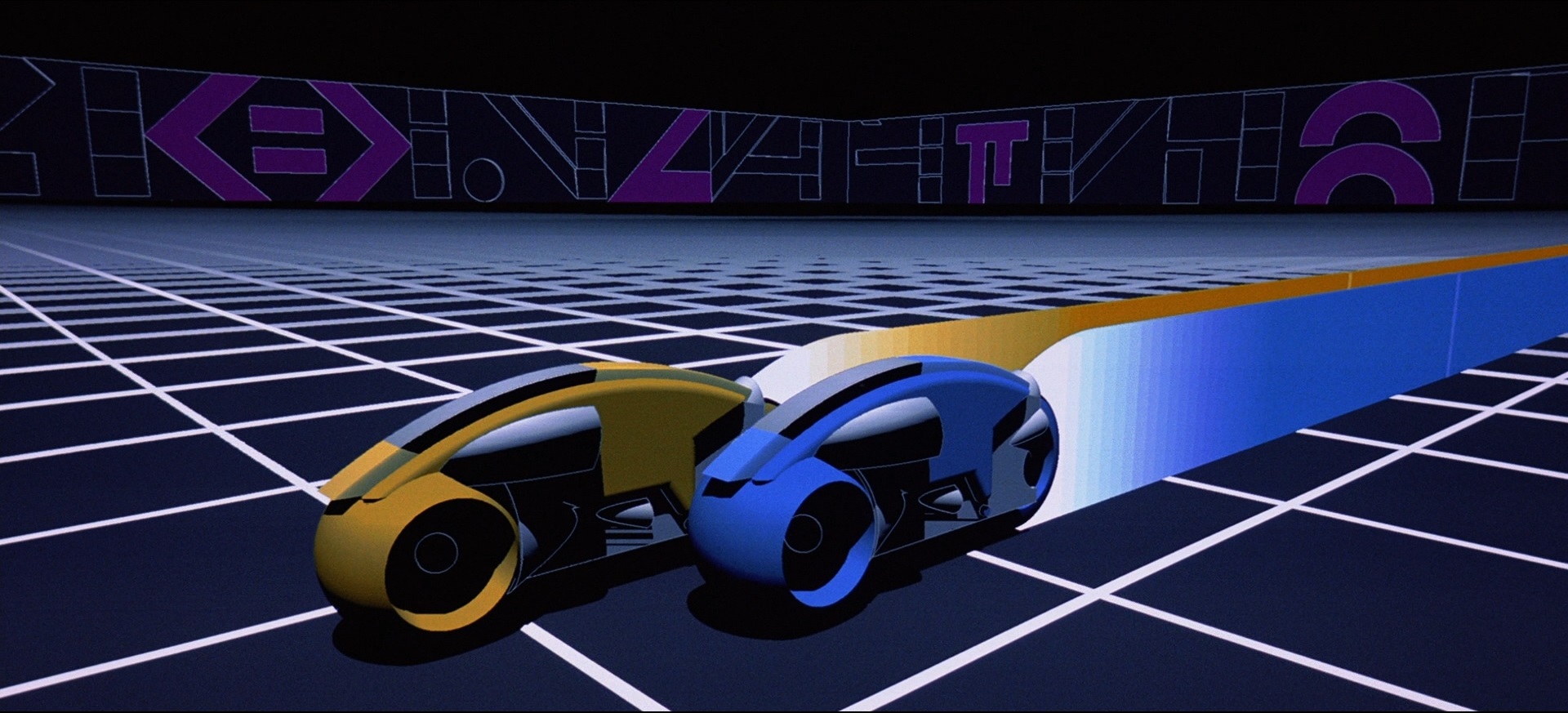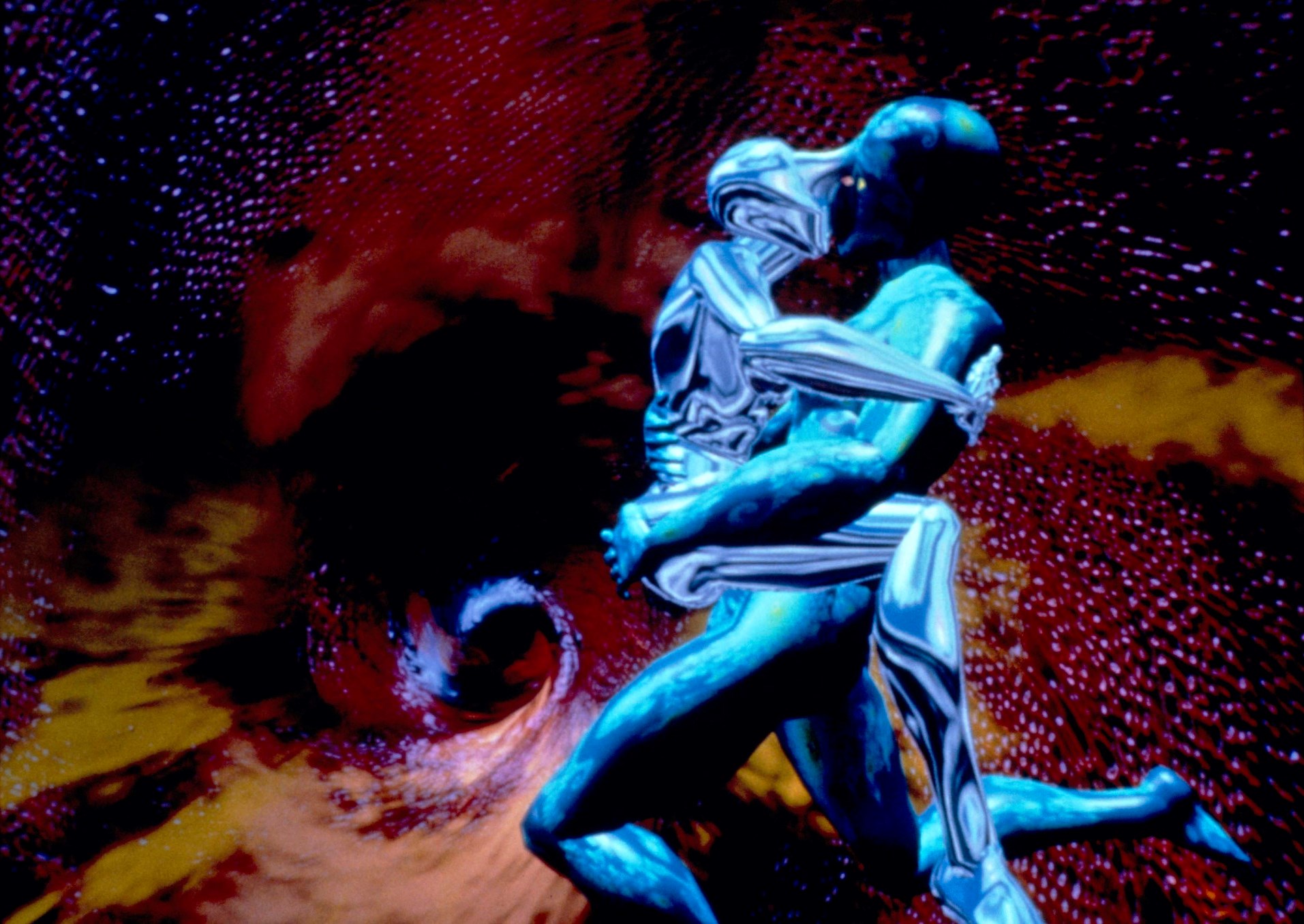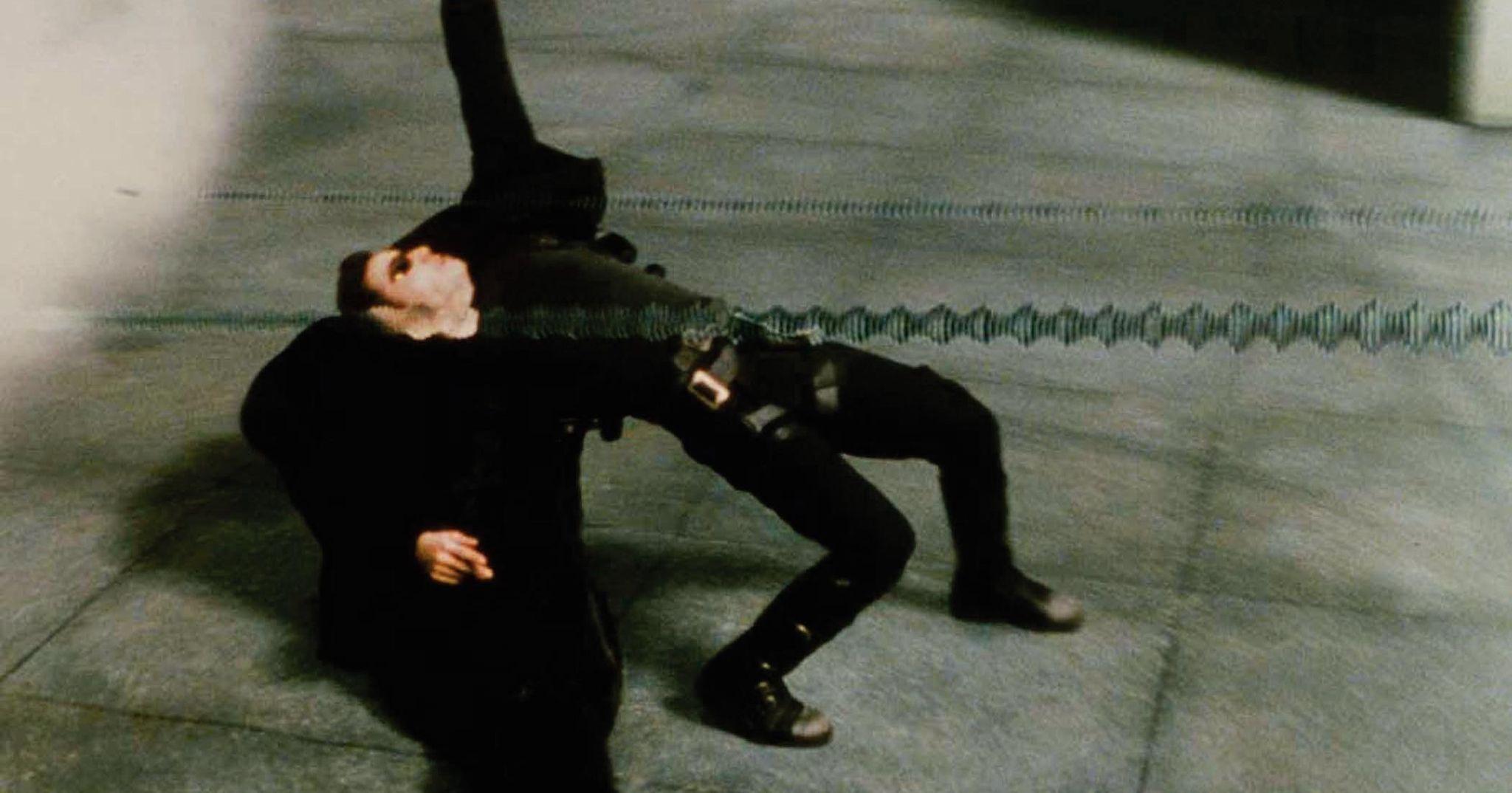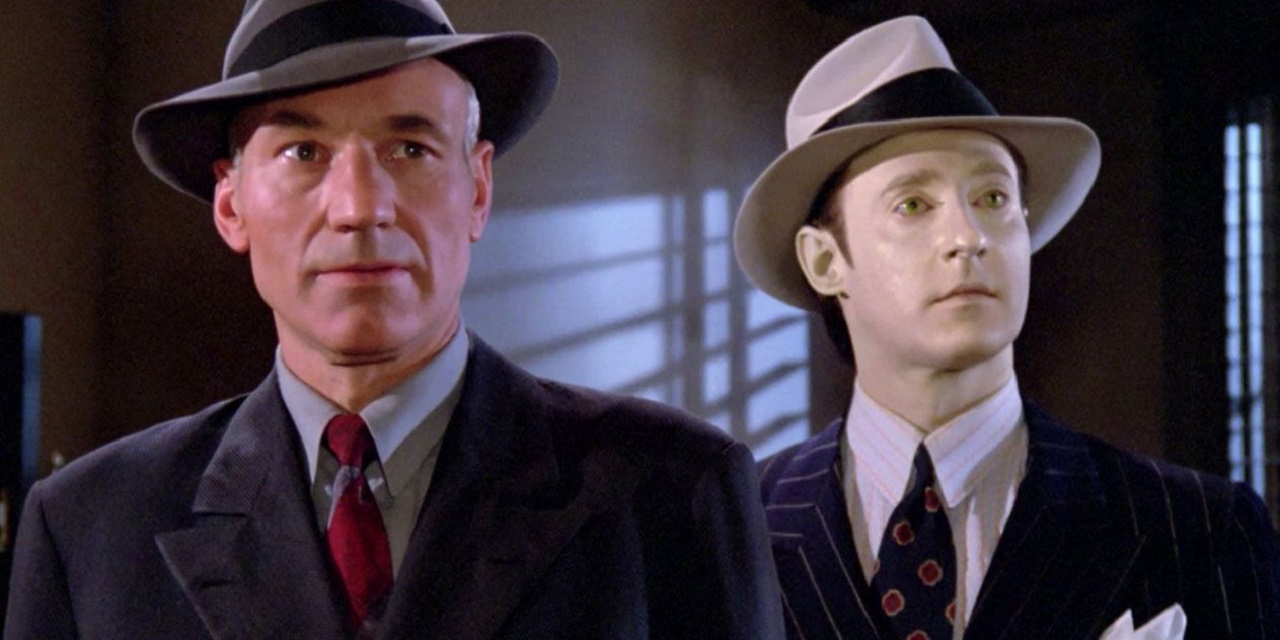Virtual Reality (or VR) refers to a computer-simulation that creates a facsimile of the real or some other world via sensory immersion. Such technology presently only exists in prototypic versions of devices such as Oculus Rift and Playstation VR. Developments are still fairly crude but it is a likely technology that will occur in the near future.
Virtual Reality is an artificial simulated environment – one that the user can move through as though it were three-dimensional; can experience via a headset that relays sound and vision; and react with using gloves that allow one to pick up and touch items in the environment. It is assumed that most VR will take place via helmets that enclose the head – in some versions this involves a full bodysuit.
In its depictions on screen, Virtual Reality is usually seen in terms of full sensory immersion – where the simulation replicates sight, sound and it is often implied other senses. A number of depictions float around the idea that the simulation becomes so lifelike it is indistinguishable from the real thing. So far the prototypic versions only encompass sight and sound – while gloves allow a user to touch items in current versions, there is no tactile feedback.
Computer-simulated environments are not the only form of Virtual Reality we have seen on screen. The most popular alternative is hologram simulations or the holodeck popularised by various Star Trek tv series where holograms gain a lifelike physicality and people can move through artificial environments.
Another alternative has been the recording or implantation of memories that offer simulated experiences. For other depictions where people appear in lifelike replicated environments see Simulation.
Earliest Depictions
The first screen depiction of Virtual Reality was in The Veldt segment of the Ray Bradbury anthology The Illustrated Man (1969), even though the term Virtual Reality itself was not used (or even not coined until the 1980s). In the episode, parents buy a playroom for their children that replicates any environment, only to find they prefer an African veldt scene – and that the lions are coming to life.
Also around at the time was Project X (1968), a confusing film where people from the future conduct an elaborate simulation involving implanted memories and the reconstruction of a 20th century farmhouse in order to obtain information in a spy’s mind.
Star Trek’s holodeck first appeared in the animated episode The Practical Joker (1974) where characters are trapped inside a simulation after the ship’s computer is affected by an energy field and goes amok. The Doctor Who episode The Deadly Assassin (1976) featured The Doctor and The Master fighting in a simulated computer environment prophetically called The Matrix!
The notoriously bad The Star Wars Holiday Special (1978) features the use of a prototypic VR helmet. Other claims to early depictions of Virtual Reality come in Michael Crichton’s Looker (1981) about a sinister plot to eliminate models for tv commercials after their likenesses have been replaced by computer simulated figures.

The first major depictions of what we today regard as Virtual Reality came with Rainer Werner Fassbinder’s World on a Wire (1973) concerning the discovery of a simulated world inside a computer environment. The other was Welcome to Blood City (1977) about a strange Western town where a group of people wake with no memory and are forced to fight for their lives before this is revealed in a twist ending to be a VR simulation for law enforcement trainees.
The first depiction of cyberspace came in Disney’s Tron (1982), a ground-breaking work that took place inside the realm of a computer, a world strikingly designed along the geometric patterns and the candy colours of a videogame where programmers had analogues as characters inside the videogames.
Tron begat the muddled Charles Band produced The Dungeonmaster/Ragewar: The Challenges of Excalibrate (1984) in which a warrior sent on a series of virtual adventures by an avatar of The Devil, leading to an anthology of short films. Band later returned to the VR anthology with Quadrant (2024).
Also dealing with VR themes was Brainstorm (1983), which concerns the development of a device that can record and replay human experience. We see a number of intriguing possibilities this is put to including recording sexual experience, psychotic episodes and even someone’s dying moments.
Virtual Reality: The Coming Paradigm of the 1990s
VR started to gain life inside literary science-fiction in the 1980s and this soon bled through to screen works. The John Varley adapted tv movie Overdrawn at the Memory Bank (1985) concerned a corporate executive whose mind is accidentally transferred into a virtual simulation. There was also Megaville (1990), a dull film concerning the fight over a new VR application, and Future Kick (1991), one of the first films to use the “it was all a VR illusion” twist ending. Mindwarp (1992) depicted a future where citizens all lived inside VR, where the heroine was banished to a post-holocaust wasteland for her rebellion, only for this to be revealed at the end to be another VR illusion, created to teach her a lesson.
One of the earliest depictions of Virtual Reality came in Total Recall (1990). Rather than depicting a computer-created realm, this gave us a future where one can have virtual memories implanted and remember undergoing adventure scenarios that they never did in actuality. The story has Arnold Schwarzenegger as a construction worker who selects the virtual memories of a spy adventure on Mars only to find that these uncover a blanked identity where he really was a spy on Mars. The artificial memories theme has been used in other films such as OtherLife (2017) – other examples are dealt with under Altered Memory.
The big breakthrough work was The Lawnmower Man (1992), a conceptually absurd film where scientist Pierce Brosnan uses VR to somehow turn an intellectually handicapped gardener into a psychic genius. What made The Lawnmower Man a hit was the ground-breaking computer graphic effects used to depict the virtual environment. An even sillier work was the sequel Lawnmower Man II: Beyond Cyberspace/Lawnmower Man II: Jobe’s War (1996), which had the psychic genius trying to become a messiah in cyberspace.
After The Lawnmower Man, there were a host of cheap copycat virtual reality films. These include Arcade (1994) with teenagers trapped inside an artificially intelligent videogame and Brainscan (1994) where Edward Furlong dealt with the title VR horror game, which urges him to kill and messes with his sense of what is real.
The trapped-inside-a-virtual videogame theme also appears in films like Spy Kids 3-D: Game Over (2003), RPG (2013) and The Call-Up (2016). The tv series Caprica (2009) featured a vast virtual gameworld. Virtual Death Match (2020) featured various contestants in a VR death game, while Spy Kids: Armageddon (2023) featured a climactic showdown with a villain inside a virtual videogame.

Virtuosity (1995) featured Russell Crowe as a VR composite of serial killer profiles who is brought to life in the real world, incarnated in a nanotech body. Virtual Combat (1995) was an action film where the malevolent AI from a game takes on form in the physical world, while Carver’s Gate (1995) featured a device that allowed virtual videogame characters to escape into the real world. The Cyberpunk film Nirvana (1997) featured a character inside a VR game becoming aware of the outside world.
After The Lawnmower Man, low-budget filmmakers quickly adopted VR themes. Many made a beeline for erotic possibilities with the likes of Virtual Sex (1993), Virtual Seduction (1995), Club V.R. (1996), Hungry for You (1996), Virtual Encounters (1996), Virtual Terror (1996), Lurid Tales: The Castle Queen (1998), Virtual Girl (1998) and Virtual Nightmare (2000).
Suddenly everyone wanted to use VR themes. These included the likes of Final Mission (1993) about the use of VR targeting systems to brainwash Air Force pilots; the entirely ridiculous Ghost in the Machine (1994) about a serial killer who becomes translated into cyberspace and ends up somehow able to control machinery; the tv series VR Troopers (1994-6) featuring teens fighting off threats from virtual reality; the tv series VR. 5 (1995) where Lori Singer discovers a secret virtual world left by her father; while VR prisons feature in both Cyber Vengeance (1995), where paying elites are able to hunt inmates, and Darkdrive (1997); Dreamtrips (1999) where a woman becomes lost in a simulation of her dreams; Ghost Machine (2009) where a VR simulation is invaded by a ghost; and the Christmas episode of the horror anthology Holidays (2016).
For a time, VR turned up in all sorts of odd films including the Michael Crichton-based sexual harassment thriller Disclosure (1994) and the slasher film Jason X (2001), even an episode of Mad About You entitled Virtual Reality (1994), while Batman became trapped in VR by The Riddler in the What is Reality? (1992) episode of the animated Batman series. Virtual Sexuality (1999) was a teen romance where VR was used as an explain-all that caused a teenage girl’s idealised guy to suddenly be made flesh after a computer glitch. Level Five (1996) was really a documentary about the Battle of Okinawa with a wraparound involving VR games. Digimon: The Movie (2000) is a copy of the Pokemon phenomenon concerning cute creatures that inhabit the internet. There’s even a VR gag at the end of the James Bond film Die Another Day (2002) and a VR scheme that is part of the villain’s plot in the teenage spy film Stormbreaker (2006). Death House (2017) features notorious killers imprisoned inside simulations of their crimes.
Some of these became decidedly strange. Conceiving Ada (1997), while largely a biopic of Ada Byron, the real-life creator of the computer, has her recreated as an avatar in cyberspace. The alien invasion film The Second Arrival (1998) featured the bizarre notion of a virtual space station. Chemical Wedding (2008), a film about the resurrection of occultist Aleister Crowley, features quantum experiments inside VR. The most ridiculous of these was Savage (1995) about a corporate villain trying to discover the secrets of immortality from the lost Atlantean civilisation who transferred themselves into cyberspace.
Virtual Reality was spoofed in Doug’s 1st Movie (1999) where a VR helmet transports the wearer into a simulacrum of the room they are standing in, as well as in a gag scene in Johnny English Strikes Again (2018). There was also the indescribable surrealist film Jesus Shows You the Way to the Highway (2019), which offers a depiction of VR using 1990s technology.
VR Comes of Age
We gradually started to see more mature treatments. Strange Days (1995) went one beyond Brainstorm and depicted a blackmarket trade in tapes that are recorded from human memory and a VR device that can play them back. One of the most substantial films to emerge was the Spanish Open Your Eyes (1997) wherein a playboy finds himself in a series of bewildering reality disjunctions that are eventually revealed to be inside a VR simulation. The film was given a Hollywood remake as Vanilla Sky (2001) starring Tom Cruise.
1999 was the year the genre came to a head and brought a whole host of VR films with David Cronenberg’s eXistenZ (1999) about the war for control of a VR game; The Thirteenth Floor (1999) where a programmer discovers the characters inside a VR program are becoming aware of the outside world; and a completely off-the-wall effort with Revelation (1999) and its sequel Tribulation (2000), Christian-made Biblical End Times films that had the Anti-Christ manifesting inside VR. There was also the short-lived tv series Harsh Realm (1999) from The X Files (1993-2002, 2016-8) creator Chris Carter, about the battle for a vast virtual simulated world.
However, the work that became the benchmark for the genre thereafter was The Matrix (1999) from The Wachowskis, a work that redefined the nature of the VR film with its vision of the entire world as being a VR illusion with humanity forced to service malevolent AIs where one can gain a mastery of the realm and manipulate the illusion to gain incredible powers. The world of The Matrix was continued in three sequels, The Matrix Reloaded (2003), The Matrix Revolutions (2003) and The Matrix Resurrections (2021). There was also The Animatrix (2003), a series of animated shorts that contained some often thoughtful meditations on the world the Wachowskis had created – in particular, the segment Beyond took place in a part of the world where the Matrix had broken down and children found they could defy the rules of the universe.

The striking Japanese film Avalon (2001) had players gradually becoming aware that the environment they are inside is a videogame simulation. This led to a less imaginative sequel Assault Girls (2009). Free Guy (2021) is a comedy variation in which Ryan Reynolds wakes up to the realisation that is a character inside a videogame.
These quickly led to the establishment of the cliche twist ending where everything is revealed to be taking part of a virtual illusion, which plays out in films such as Open Your Eyes, eXistenZ, The Thirteenth Floor, Avalon, Repo Men (2010) and Flashburn (2017). The most ridiculous examples of this was the twists that come in Serenity (2019) and Ghosts of War (2020). Cargo (2009) borrows from The Matrix with its idea that an attempt to colonise a planet has gone wrong and so the colonists are kept in an illusion of being in an ideal paradise.
The Singularity is Near: A True Story About the Future (2010) is a documentary in SF form about the developments of technology and augmented reality. Let’s Be Evil (2016) concerns sinister experiments with augmented reality (the computer enhancement of the real world via information and sensory overlays).
VR in Cyberpunk
Virtual Reality has become synonymous with Cyberpunk. Indeed, it was William Gibson’s attempts to visually depict the world of the computer in the seminal Cyberpunk novel Neuromancer (1984) that popularised the term ‘cyberspace’. (More detailed discussion of Cyberpunk can be found under Cyberpunk Films). Gibson’s work has long been announced for film treatment and has been brought to the screen in Johnny Mnemonic (1995) and New Rose Hotel (1998), although only the former contains VR scenes.
VR turns up in the background of various Cyberpunk films Cybertech P.D./Terminal Justice (1995), which features a character who is a virtual sex star and a showdown inside a VR game; the TekWar episode Carlotta’s Room (1995) concerning VR prostitutes; the aforementioned Nirvana (1997); the cloning film The 6th Day (2000), which features virtual girlfriends, psychologists and attorneys; Hardwired (2009) concerning neural advertising implants; Ghosts With Shit Jobs (2012) featuring a vast simulation of the present-day; and much usage in the tv series Altered Carbon (2018-20), including applications of VR torture and an entire virtual hotel.
Some of the most sophisticated Cyberpunk films have been in Anime. There was the excellent Ghost in the Shell (1995), which features a worker on a quest to find his wife and child, unaware they are artificial memory implants, while VR scenes appear in various of the follow-ups Ghost in the Shell 2: Innocence (2004), Ghost in the Shell: Arise (2013-4), Ghost in the Shell: The New Movie (2015) and the tv series’ Ghost in the Shell: Stand Alone Complex (2002) and Ghost in the Shell SAC_2045 (2020-2), as well as the best forgotten English-language remake Ghost in the Shell (2017). Mamoru Hosoda’s Belle (2021) was a version of Beauty and the Beast retold in Virtual Reality.
There are minor elements in films such as Digital Man (1995) and Teen Titans Go! vs Teen Titans (2019), which feature VR combat training programs; Code 46 (2003) where Tim Robbins does his daily exercise using a VR boxing simulator; and the drug simulations in Divergent (2014) and sequels.
VR is merely part of the background of the future in other works like 1,2,3 Whiteout: The End of the Light Age (2007), The Zero Theorem (2013), Haphead (2015), Hot Tub Time Machine 2 (2016) and Death Race 2050 (2017).
Other Developments
One of the stranger iterations of virtual reality themes was the popular conspiracy theory belief that we are all living in The Matrix and that the world around us is part of a virtual simulation. This is depicted in The Mandela Effect (2019), which shows a programmer trying to hack the simulation. A Glitch in the Matrix (2021) is a documentary exploring the idea, including the story of a real-life murder case where the accused used his belief that he was living in The Matrix as a defence.
The ‘We Are All Living in The Matrix’ idea carries through in a number of other works including Bliss (2021) where Owen Wilson discovers that the present world is a virtual illusion and Discontinued (2022) where the whole world faces the announcement that the simulation is being shut down. Things are revealed to be taking place in a vast simulated world in the third season of tv’s Westworld (2016-22), while the idea was spoofed in the Futurama episode All the Way Down (2023).
The tv mini-series Devs (2020) concerns the creation of a super-computer to model every particle and its behaviours and ends with the protagonists incarnated inside the simulation. The William Gibson-adapted tv series The Peripheral (2022) dealt with the discovery of a VR device that can allow immersive interaction with an alternate future.
Some of the most creative treatments of VR have been in the anthology tv series Black Mirror (2011- ). The episode San Junipero (2016) is set in a virtual resort where the simulated dead live on. The episode USS Callister (2017) is a savage parody of Star Trek featuring simulated characters trapped in a cruel environment. In the episode Striking Vipers (2019), characters develop relationships while in their videogame avatar personas.
Steven Spielberg’s Ready Player One (2018) involves a treasure hunt that takes place across a vast virtual realm that recreates detailed simulacra of 1980s pop trivia. Space Jam: A New Legacy (2021) locates the toon basketball game of its predecessor in a virtual universe inhabited by characters from various Warner Brothers intellectual properties.
An intelligent treatment came in LX 2048 (2020) where a man struggles to connect with his family who spend all their time in Virtual Reality and is thrown out by his wife who accuses him of infidelity after finding him having sex with an avatar body.
The tv series Reverie (2018) concerned a hostage negotiator who is employed to rescue people trapped in a VR simulation. Don’t Worry Darling (2022) featured a secret VR project where men imprison their wives inside an idyllic 1950s world where they are happy, servile housewives.

There has also grown the idea of the Avatar – an artificial body that is remotely controlled by someone at a distance. Surrogates (2009) postulated a future where people inhabited avatar bodies as more preferable to the mundane real thing. Gamer (2009) concerned prisoners being controlled as player characters in live-action videogames. The classic treatment was James Cameron’s Avatar (2009) where colonists used avatar bodies to survive and mingle with the natives on an alien world. The Electric State (2025) features humanity having adopted robot body avatars.
S1m0ne (2002) concerned the creation of a virtual Hollywood actress by a producer who is forced to go to great lengths to maintain the pretence that she is a real person. The Congress (2013) concerns a Hollywood actress allowing her virtual likeness to be created and depicts a future where the entire populace exists inside a drug-induced consensual hallucination.
The Belgian film Thomas in Love (2000) concerns an extreme agoraphobe who never goes out of doors and the relationships he develops in cyberspace. In Creative Control (2015), a man conducts an affair with a VR copy of friend’s girlfriend using augmented reality glasses. The Cyberpunk pornographic film I.K.U. (2000) concerns androids that consume sexual experience and then broadcast it via the net. Mnemophrenia (2019) is a film that addresses the concern that VR use ends up producing the titular syndrome – a series of artificial memories unable to be distinguished from the real thing.
The dystopian film FAQ: Frequently Asked Questions (2004) features a future where illicit images of sensuality and human contact are broadcast in VR by a rebel underground. Aeon Flux (2005) features a future where a rebels underground meets virtually via pills that are swallowed.
The Argentinean cartoon Mercano the Martian (2002) has a lonely Martian setting up a simulation of Mars in cyberspace and then a battle for control of it. The tv series’ Three-Body (2023) and 3 Body Problem (2024- ) concern an advanced VR videogame created by an alien race as a means of testing human minds.
VR is used as a form of psychotherapy in Game Over (2019) and ClearMind (2024); for neurological memory recovery in Black Box (2020); as a means of contacting a comatose patient in Demonic (2021); and for holding church services in Resurrected (2023). Elsewhere, in the tv mini-series Vortex (2022), a glitch in the system allows a man to contact his dead wife and try to prevent her murder.
Holograms
One of the precursors to VR was the hologram. Hologrammatic entertainment appears in The Star Wars Holiday Special (1978), which included what may well be the very first filmic depiction of cybersex. The Magnetic Rose episode of the anime Memories (1995) has a salvage crew trapped inside the spacegoing hologrammatic mausoleum dedicated to an opera star.
The most famous usage of the hologram has been the holodeck in the various modern Star Trek series beginning with Star Trek: The Next Generation (1987-94) and continuing through Star Trek: Deep Space Nine (1992-9), Star Trek: Voyager (1995-2001) and Star Trek: Picard (2020-23) and background appearances in the film spinoffs Star Trek: Generations (1994), Star Trek: First Contact (1996), Star Trek: Insurrection (1998) and Star Trek: Nemesis (2002).

In these, the holodeck is used as a realm where characters appear in interactive scenarios for recreation, or where it is used for training purposes, to several stories where crew become trapped in simulacra. A number of holodeck stories place the characters inside pastiches of film noir, Sherlock Holmes, Westerns or spy films.
Some of the more fascinating holodeck stories dealt with holographic characters that gain an awareness of their own identity – in particular the character of The Doctor, an emergency medical hologram who became a regular in Star Trek: Voyager. There was even the Deep Space Nine episode Shadowplay (1994) where we encountered an entire town who do not realise they are holograms.
Another popular hologram is the ongoing character of Rimmer (Chris Barrie) in the tv series Red Dwarf (1988- ). The hologram is also used in the film Marjorie Prime (2017) set in a future where people create simulations of departed loved ones to keep them company. Sophisticated interactive hologram characters appear in Blade Runner 2049 (2017) and the tv series Altered Carbon, which features a hologram hotel and A.I. simulation of Edgar Allan Poe.
Recommendations
- World on a Wire (1973)
- Tron (1982)
- Brainstorm (1983)
- Star Trek: The Next Generation (tv series, 1987-94)
- Ghost in the Shell (1995)
- Star Trek: Voyager (tv series, 1995-2001)
- Strange Days (1995)
- Nirvana (1997)
- Open Your Eyes (1997)
- eXistenZ (1999)
- The Matrix (1999)
- Avalon (2001)
- The Animatrix (2003)
- Black Mirror (tv series, 2011- )
- Altered Carbon (tv series, 2018-20)
- LX 2048 (2020)
- Bliss (2021)
- A Glitch in the Matrix (2021)
A full list of titles can be found here Virtual Reality

